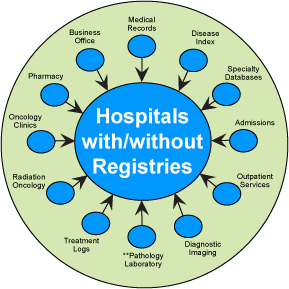Hospital Registry Data Sources

Hospital data sources are areas or departments within a hospital that provide medical care to the patient and record the results.
Medical Records
Paper-based or computerized information recorded during the patient's encounters with the facility. Patient medical records are the primary source of patient identification, diagnosis, and treatment information.
Disease Index
A numerically sequenced list of diseases and conditions diagnosed in hospital patients. Diseases and conditions identified in patient medical records are coded using a standard classification system such as ICD-9-CM or CPT (Current Procedural Terminology). The disease index, compiled from these codes, is a casefinding source for the cancer registry.
Specialty Databases
Collections of data that describe a hospital's diagnostic and treatment experience with a specific disease. They are tools for improving the quality of care and measuring the effectiveness of healthcare delivery for that disease. An example is the cancer registry database, which contains cancer-related information abstracted from patient medical records and patient follow-up data gathered from outside sources.
Admissions
The hospital department that processes patient admissions and generates key patient identification and demographic data, including the patient's name, address, date of birth, race, sex, Social Security number, and insurance carrier.
Outpatient Services
Ambulatory services provided to patients in hospital-based clinics and departments where the length of stay is less than 24 hours. Documentation of outpatient services, which includes the patient's medical history, physical examination, diagnostic and therapeutic procedures, consultations, observations, and discharge notes, usually is integrated with the patient's inpatient medical record to form a unified hospital medical record.
Diagnostic Imaging
The hospital department that creates images of structural or functional patterns of human organs or tissues for the purpose of identifying, diagnosing, or monitoring disease. Radiographs (X-rays), fluoroscopy, ultrasound, mammography, computerized tomography (CT scans), positron emission tomography (PET scans), magnetic resonance imaging (MRI scans), and nuclear medicine imaging are included. Information reported from diagnostic imaging includes the type of study, body location, description and evaluation of the image, and diagnosis.
Pathology Laboratory
A department that examines organs, tissues, cells, and bodily fluids removed from patients for the investigation and diagnosis of disease, and conducts autopsies to study disease processes and to determine cause of death. Pathology reports include the type of material examined, body location from which the specimen was taken, gross and microscopic description and evaluation of tissues, components of bodily fluids, and diagnosis. A pathology laboratory may be required to report cancer cases to the central registry, to respond to inquiries from the central registry, or to allow central registry access to pathology records.
Treatment Logs
Daily records of treatment given or procedures performed in a hospital department such as a surgery unit or an outpatient chemotherapy clinic. They generally include patient identifiers, procedures performed, diagnosis, and practitioners, and are a source of casefinding data.
Radiation Oncology
The department that provides curative, adjuvant, or palliative cancer treatment using radiation to control malignant cells. Radiation may be given as external beam radiotherapy, brachytherapy or implantation of radioactive sources, or injection or ingestion of radioactive materials. Radiation oncology documentation, which may be maintained separate from the hospital medical record, includes pre-treatment consultation summarizing the cancer diagnosis and treatment to date, treatment planning and daily dose delivery, treatment summary, and patient follow-up visits.
Oncology Clinics
Ambulatory care units responsible for staging, medical treatment, and follow-up of cancer patients in a hospital. A clinic may focus on a particular cancer site such as breast cancer, provide a centralized setting for chemotherapy administration, or coordinate all services provided to oncology patients throughout the facility. Medical oncology documentation varies according to the services provided and may be separate from the hospital medical record.
Pharmacy
A hospital pharmacy maintains the hospital formulary, stocks and releases drugs for treatment as ordered by physicians, addresses complex clinical medication management issues, and provides information on available drugs, including generic and brand names, disease-specific prescriptions, and drugs administered to individual patients.
Business Office
The department responsible for billing and collecting payment from individuals or third-party payors for healthcare services rendered by the facility. It provides information on the financial statement submitted for payment.
**Pathology laboratories send data to both hospital registries and central cancer registries.
- Page last reviewed: January 6, 2016
- Page last updated: January 6, 2016
- Content source:
- Maintained By:


 ShareCompartir
ShareCompartir